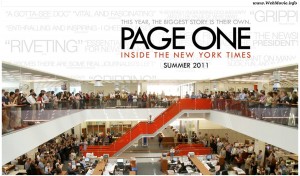Gaining unprecedented access to the beacon of North American print journalism at arguably its’ most tenuous state, Page One: Inside the New York Times is a captivating documentary that follows the hollowed paper as it transitions into a new age of media. Spending the better part of a year that covers the end of 2009 into 2010 with the various departments and employees of the New York Times, Andrew Rossi’s documentary paints a picture of a prideful paper rooted in tradition, but prepared for change. From quick-thinking and quirky media columnist David Carr to the thoughtful and well-spoken executive editor Bill Keller, the movie introduces the audience to some of the paper’s key players while exploring a variety of themes – chief among them, the perceived death of print journalism.
In an age where words like Twitter and WikiLeaks exploded onto the scene and took all forms of media by storm, the New York Times, a constant in print journalism since its inception in 1851, found itself standing after many others fell. As print staple parent company Tribune filed for bankruptcy and popular long-standing papers like the Rocky Mountain News closed its’ doors for good, the Times stands in resilience, a proud fighter that’s taken a fair share of blows – and yet refuses to bow out. As financial reports and investigative reviews begin to count out the paper, the Times and its’ staff churns on, finding new ways to stay relevant and profitable in an era where news is obtained in simpler and cheaper ways. As production costs stay constant and profit margins dwindle, news media outlets nation wide cut back on employees, and at the Times it’s no different. Employees who for years poured their heart and soul into dutiful service are given sorrowful severance packages while those still standing soldier on. Of those survivors, it’s feisty reporter David Carr who serves as a constant wave in an overarching ocean of change. By the book but surprisingly willing to adapt, his uncanny survivalist instinct (hardened by years of drug addiction) serves as the perfect counter to the open-ended death sentence hanging around the paper’s neck like an albatross. If it’s employees can quickly adapt and conquer a sweeping change such as the dramatic, instantaneous arrival of Twitter, so too, can the Times.
Chugging along even as similar products fall by the wayside, the New York Times finds itself being depicted in the film in a way that would make Mark Twain blush. Reports of their demise were greatly exaggerated, and Rossi makes sure to remind the audience of that at every turn, as crafty business minds seamlessly coalesce with 150 plus years of journalist instinct to keep the Times, well, one step ahead of the times. It’s by no means the be-all, end-all answer to how print journalism can stay relevant when easier and cheaper forms of media make syndication the easy answer. But the movie captures a paper with no interest in giving up the ghost just yet. And as generational demands and creature comforts shift societal norms away from print journalism, Rossi’s documentary captures an organization in revolution, intent to keep the wheels moving forward by any means necessary.

